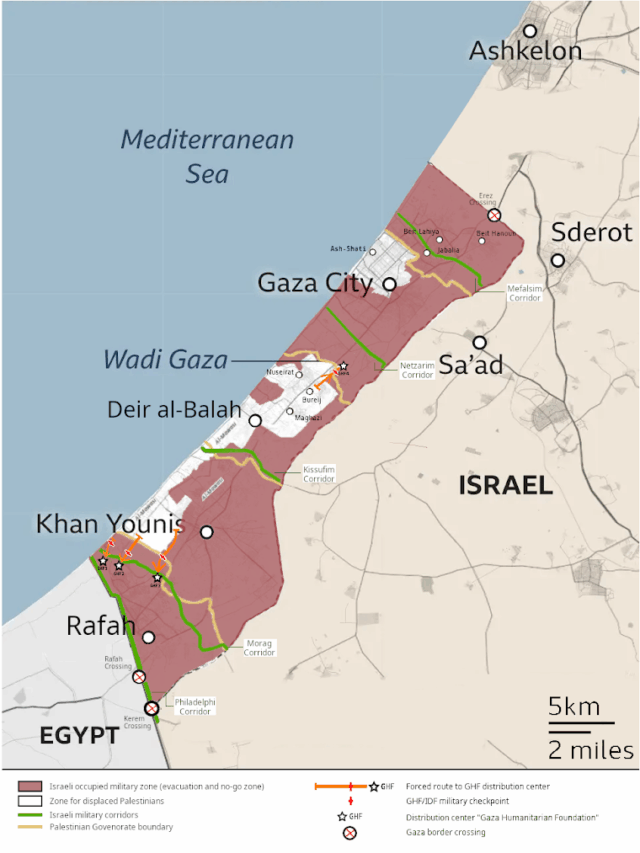Editor’s Note: Dan Linnaeus is an open source security analyst. He can be followed at @danlinnaeus.
The IDF holds about seventy-five percent of the Gaza Strip. That territory is mostly cleared, with two Hamas strongholds remaining: Gaza City and the central camps. The war cabinet debate about how to proceed came down to three options.
One was a full push into the remaining twenty-five percent at once. That would mean heavy fighting amid more than a million civilians trapped between Gaza City in the north and Khan Younis in the south—thousands likely killed and no way to clear the area without massive international blowback. Operationally, it would be chaos, costly in lives to all parties, IDF troops, remaining hostages in captivity, Hamas, Islamic Jihad, as well as Gaza’s uninvolved civilians.
On the other end of the spectrum was the Chief of Staff’s proposal, essentially to stop where we are, surround what’s left, and fight a war of attrition—raids, strikes, slow grind. That would spare forces, especially reserves who’ve been deployed for months, but wouldn’t guarantee Hamas’s defeat or enough leverage to get the hostages out.
The head of government, PM Netanyahu, took a middle path. First, evacuate roughly a million civilians out of Gaza City into the central and Deir al-Balah zones, then launch a full urban assault on Gaza City which holds Hamas’s remaining government functions, most of the senior leadership, and its strongest intact military units.
Once taken, Israel would control about eighty-five percent of the Strip, compressing remaining militants into fifteen-percent of Gaza and civilian evacuees into the coastal areas spanning Al-Mawasi and adjacent humanitarian safe-zones. The expectation is that this push might be enough to break Hamas’s grip on the enclave, politically, militarily, and socially—potentially forcing a deal for all hostages and a Hamas surrender and the withdrawal from the strip of its remaining senior commanders. If not, stage two would mirror stage one: evacuate civilians, this time from the central zones to Rafah, and then take the final Hamas stronghold.
Timing is expected to be about a month and a half for Gaza City, possibly more depending on force allocation and the pace of urban clearing. The second phase if necessary could be achieved in a comparable time-window. The Chief of Staff remains concerned about reserves—men and women with families and civilian jobs—so there’s constant balancing between pushing hard for a decisive finish to the war and keeping the reserve system sustainable. Under this plan, Israel may be able to declare a victory over Hamas and Islamic Jihad within a 3-4 months window and transition to its post-conflict policies and strategies, which involves a transitional phase of IDF military control over the entire Strip.
As part of the plan, the humanitarian component is being scaled up sharply: GHF distribution centers are going from four to sixteen, flooding the zone with aid so that civilians won’t depend on Hamas for food. This serves three overarching purposes—disposing of Hamas’s narrative that Israel is starving the population, removing Hamas’s leverage over civilians, and creating the infrastructure to later move people south in controlled stages. It also lays groundwork for large-scale voluntary relocation out of Gaza, coordinated with the U.S. and third countries. Egypt’s current block on outward movement remains a major obstacle, but Israeli planners see relocation as both a humanitarian right and a strategic goal to reshape Gaza’s demographics and security environment.
Post-war, the plan is for no Hamas, no PIJ, and no Palestinian Authority rule in Gaza. Instead, local civilian-run administrations would manage different zones, with UAE and Saudi Arabia heavily involved in education and reconstruction programs. Hamas’s overseas leadership in Qatar, Egypt, and Turkey is seen as part of the problem set and will need to be neutralized—either through exile, capture, or targeted operations.
Politically, there’s friction over the hostage issue. Netanyahu’s approach leaves room to cut a deal if Hamas offers terms during the Gaza City operation. Figures like Israel’s finance minister Smotrich oppose this outright, arguing for no more piecemeal deals—only total destruction of Hamas will ensure all hostages return according to more hawkish factions of the Israeli government. There’s fear on the right that Hamas could use an offer to bait Israel into halting operations midstream, repeating past mistakes.
In sum, Israel’s public messaging is two strongholds left, two stages to take them, no simultaneous push because of the civilian factor. The cabinet’s sequencing is north-to-south: clear Gaza City, consolidate, then push south again. U.S.-Israel coordination is tight. Both governments want a decisive Gaza victory within the year, both to lock in security gains and to create political space for wider diplomatic deals in 2026, potentially expanding the Abraham Accords to states like Oman and Indonesia. Washington is also looking at a long-term military footprint in Gaza—bases, maybe a port—arguing that Iraq and Syria are too vulnerable to sustain forward positions.
The vision is clear on both sides: dismantle Hamas completely, stabilize Gaza in a way that prevents reconstitution, and reshape the strategic map before next year. Israeli officials expect international pressure to ease significantly once there is a clear win and a credible post-war structure in place.
Parallel fronts are being managed. In Lebanon, sustained IDF strikes are degrading Hezbollah’s capabilities to the point where the Lebanese government has formally adopted a resolution to dismantle Hezbollah as an armed group. Implementation will be difficult, but this is the outcome Israel was aiming for, aided by U.S. pressure tying aid to disarmament. In Syria, Israel is reinforcing its Hermon positions, backing Druze communities, and locking in strategic depth via the David’s Corridor in southern Syria amid a fractured security situation and increasingly unstable post-Assad governance under al-Sharaa.


